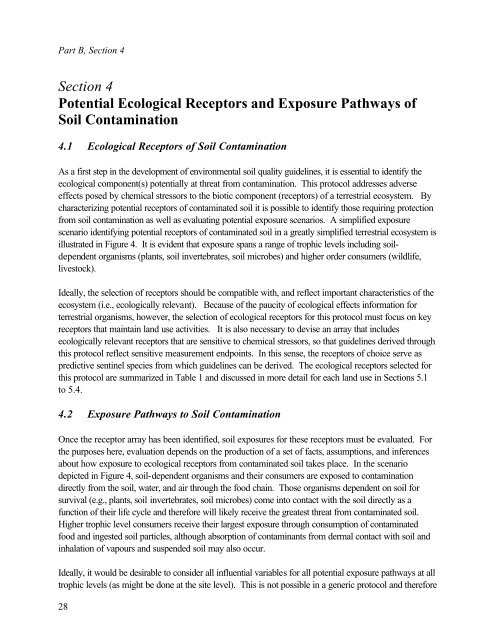Protocol for the Derivation of Environmental and Human ... - CCME
Protocol for the Derivation of Environmental and Human ... - CCME
Protocol for the Derivation of Environmental and Human ... - CCME
Create successful ePaper yourself
Turn your PDF publications into a flip-book with our unique Google optimized e-Paper software.
Part B, Section 4<br />
Section 4<br />
Potential Ecological Receptors <strong>and</strong> Exposure Pathways <strong>of</strong><br />
Soil Contamination<br />
4.1 Ecological Receptors <strong>of</strong> Soil Contamination<br />
As a first step in <strong>the</strong> development <strong>of</strong> environmental soil quality guidelines, it is essential to identify <strong>the</strong><br />
ecological component(s) potentially at threat from contamination. This protocol addresses adverse<br />
effects posed by chemical stressors to <strong>the</strong> biotic component (receptors) <strong>of</strong> a terrestrial ecosystem. By<br />
characterizing potential receptors <strong>of</strong> contaminated soil it is possible to identify those requiring protection<br />
from soil contamination as well as evaluating potential exposure scenarios. A simplified exposure<br />
scenario identifying potential receptors <strong>of</strong> contaminated soil in a greatly simplified terrestrial ecosystem is<br />
illustrated in Figure 4. It is evident that exposure spans a range <strong>of</strong> trophic levels including soildependent<br />
organisms (plants, soil invertebrates, soil microbes) <strong>and</strong> higher order consumers (wildlife,<br />
livestock).<br />
Ideally, <strong>the</strong> selection <strong>of</strong> receptors should be compatible with, <strong>and</strong> reflect important characteristics <strong>of</strong> <strong>the</strong><br />
ecosystem (i.e., ecologically relevant). Because <strong>of</strong> <strong>the</strong> paucity <strong>of</strong> ecological effects in<strong>for</strong>mation <strong>for</strong><br />
terrestrial organisms, however, <strong>the</strong> selection <strong>of</strong> ecological receptors <strong>for</strong> this protocol must focus on key<br />
receptors that maintain l<strong>and</strong> use activities. It is also necessary to devise an array that includes<br />
ecologically relevant receptors that are sensitive to chemical stressors, so that guidelines derived through<br />
this protocol reflect sensitive measurement endpoints. In this sense, <strong>the</strong> receptors <strong>of</strong> choice serve as<br />
predictive sentinel species from which guidelines can be derived. The ecological receptors selected <strong>for</strong><br />
this protocol are summarized in Table 1 <strong>and</strong> discussed in more detail <strong>for</strong> each l<strong>and</strong> use in Sections 5.1<br />
to 5.4.<br />
4.2 Exposure Pathways to Soil Contamination<br />
Once <strong>the</strong> receptor array has been identified, soil exposures <strong>for</strong> <strong>the</strong>se receptors must be evaluated. For<br />
<strong>the</strong> purposes here, evaluation depends on <strong>the</strong> production <strong>of</strong> a set <strong>of</strong> facts, assumptions, <strong>and</strong> inferences<br />
about how exposure to ecological receptors from contaminated soil takes place. In <strong>the</strong> scenario<br />
depicted in Figure 4, soil-dependent organisms <strong>and</strong> <strong>the</strong>ir consumers are exposed to contamination<br />
directly from <strong>the</strong> soil, water, <strong>and</strong> air through <strong>the</strong> food chain. Those organisms dependent on soil <strong>for</strong><br />
survival (e.g., plants, soil invertebrates, soil microbes) come into contact with <strong>the</strong> soil directly as a<br />
function <strong>of</strong> <strong>the</strong>ir life cycle <strong>and</strong> <strong>the</strong>re<strong>for</strong>e will likely receive <strong>the</strong> greatest threat from contaminated soil.<br />
Higher trophic level consumers receive <strong>the</strong>ir largest exposure through consumption <strong>of</strong> contaminated<br />
food <strong>and</strong> ingested soil particles, although absorption <strong>of</strong> contaminants from dermal contact with soil <strong>and</strong><br />
inhalation <strong>of</strong> vapours <strong>and</strong> suspended soil may also occur.<br />
Ideally, it would be desirable to consider all influential variables <strong>for</strong> all potential exposure pathways at all<br />
trophic levels (as might be done at <strong>the</strong> site level). This is not possible in a generic protocol <strong>and</strong> <strong>the</strong>re<strong>for</strong>e<br />
28
















